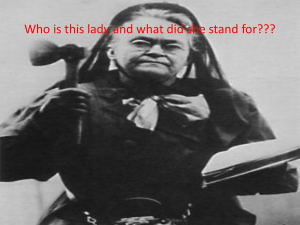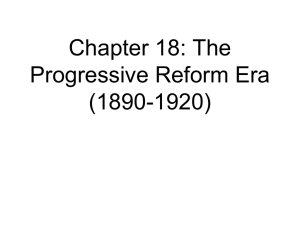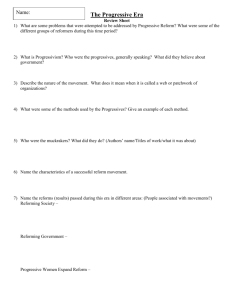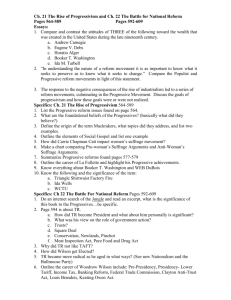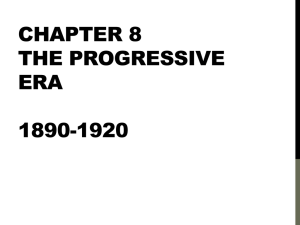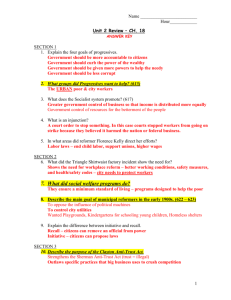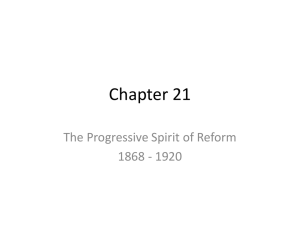Ch 18 Progressive Reform notes
advertisement
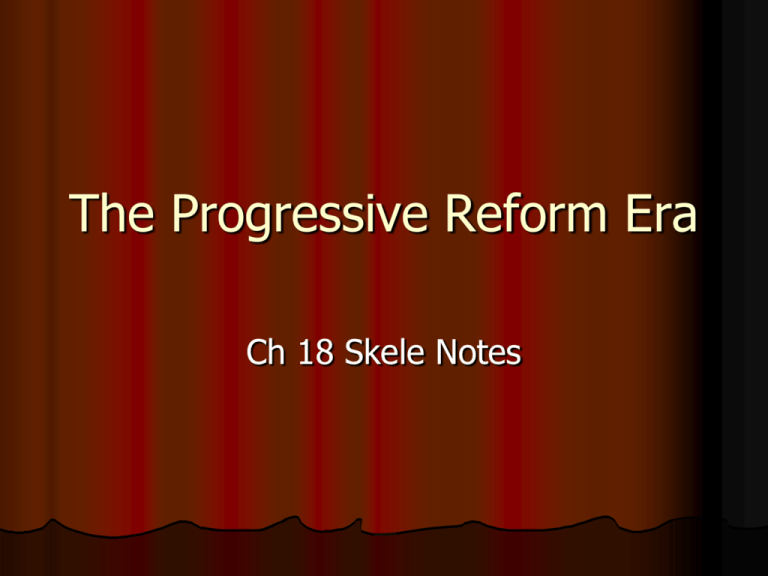
The Progressive Reform Era Ch 18 Skele Notes 18.1 The Origins of Progressivism Progressive Era: 1890-1920, a lot of reform going on Roots of Reform (reacting to) Outgrowth of earlier reform in the Northeast, Midwest, and West Coast Immigration Urbanization: low pay, poor housing Work environments Corruption in the gov Included people from all political parties Most were of average wealth/middle class Goals Didn’t share same views Goals fell into 4 categories Social Moral Economic Political Some overlapped Some conflicted Beliefs Gov should be more accountable to its citizens Gov should curb power and influence of wealthy interests Gov should be given expanded powers so it could become more active in improving lives of its citizens Gov should become more efficient and less corrupt so they could competently handle an expanding role Key Writers Henry George: wrote Progress and Poverty in effort to explain why poverty plagued such an advanced civilization Proposed a single tax on the value of land Edward Bellamy published Looking Backward where a man wakes up in 2000 and finds the US transformed into a utopian country Clubs formed supporting both men’s works More on Writers Many became scientific in their work and published their findings about our society Hoped the public would push legislators to make and enforce new laws Muckrakers: journalists who uncovered information in an area of social reform and published their findings Ex: Upton Sinclair’s The Jungle (meat packing ind), Lincoln Steffens The Shame of the Cities (corruption in cities), Ida Tarbell about Standard Oil Trust’s abuses Reform Organizations Union Movement: 1890s If unions succeeded in forming, business leaders often used court to issue injunctions (court order prohibiting something) preventing strike Did have success with collective bargaining Socialists: public/gov control of property and income Elect leaders to do this, not through revolution Most progressives didn’t support such huge changes Wanted to get rid of corruption and help the poor Women’s Groups National Consumers’ League (NCL) Investigated conditions in which goods were made and sold Insisted factories obey state inspection laws and pay minimum wage Women believed they needed the right to vote to get gov to create services essential to a family’s health Focused on liquor, workplace conditions, and commercialized vice Powerless without the right to vote Important Women Florence Kelley: Hull House Enforcer of law prohibiting child labor, limiting work hours for women, and regulating sweatshop conditions in IL Earned a law degree Involved in NCL – general secretary “Mother Jones” Mary Harris Jones Worked with Knights of Labor Organized unions for workers (men and women) Became national speaker on unions and child labor laws 1905 helped form IWW 18.2 Progressive Legislation Social Welfare Programs Ensure minimum standard of living for people Ex: minimum wage, unemployment benefits, accident and health insurance, social security system Municipal level reforms: city level Most early reforms Pushed for home rule: system that gives cities and limited degree of self rule Allowed them to escape rule of state level political machines Dealt with ending corruption (political machines) Some political machines worked with reformers Why did people want municipal reforms? Many tragic events made people want these reforms Galveston: model of management Commission (5) ran things, not just one person Dayton: first big city to do a councilmanagement gov Elected city council which sets laws and appointed a professional city manager to run city services City Reforms Take over Utilities Made efforts to regulate or dislodge monopolies that provided city utilities like water, gas, and electricity By 1915 nearly 2 of 3 cities had some cityowned utilities Provide Welfare Services Some reform mayors led movements for citysupported welfare services State Reforms First worked to oust political bosses then change things Robert La Follette (Wis.) began direct primary: voters choose who should run for office Initiative: citizens can propose new law through petition signatures and get it on the ballot Referendum: citizens can approve/reject a law passed by the legislature Recall: voters can remove person from office before the next election Workplace Reforms Labor depts: provide information and dispute-resolution services to employers and employees Went to court with business owners saying gov shouldn’t get involved in business Lochner v. New York (1905), the Supreme Court struck down a law setting maximum hours for bakers Muller v. Oregon the Court upheld an Oregon law that limited hours for female laundry workers to 10 hours a day Health issues By 1907, nearly two thirds of the states had abolished child labor Minimum wage laws for women and children also made headway Fighting Bob La Follette Ousted party bosses and brought about structural changes such as a direct primary and civil service reform “Wisconsin Idea” called on academic experts to help draft reform legislation. To get it passed, he had the voting roll call read publicly in the districts of legislators who opposed reform. Served in Senate after governor Federal Reforms Theodore Roosevelt was a powerhouse for reform as president “Square Deal” arbitration in mining strike; TR felt was fair to both sides (check book for details) “Square Deal” became slogan for his presidency Progressive Reform Legislation 18.3 Taft’s Presidency Taft chosen by TR, but disappointed many Payne-Aldrich Tariff: a protective tariff, not supported by Progressives Ballinger-Pinchot Affair: dispute over lands in Alaska and their being sold for business purposes (coal), ended in Taft looking bad again New Nationalism TR campaigned for Progressives in the interim elections of 1910 Called for business regulation, welfare laws, workplace protection for women and children, income and inheritance taxes, and voting reform Progressive Democrats won many seats in Congress Election of 1912 Republicans: Taft Progressives formed own party: “Bull Moose Party” with TR as candidate tariff reduction, women's suffrage, more regulation of business, a child labor ban, an eight-hour workday, a federal workers' compensation system, and the direct election of senators Democrats: Woodrow Wilson and “New Freedom” policy- promised to enforce antitrust laws without threatening economic competition Wilson won because Republican vote was split Wilson’s Presidency Underwood Tariff Act of 1913 reduced average tariff rates from 40 percent to 25 percent October 1913 Wilson signed into law a federal income tax, made legal with ratification of the Sixteenth Amendment (to make up for loss in revenue) “Trust Busting” Clayton Antitrust Act (1914): spelled out specific activities that big businesses could not do Companies could not prevent their buyers from purchasing goods from competitors Some types of holding companies used to create monopolies were banned Price cutting in local markets to squeeze out competitors was forbidden, as were some rebates. Legalized unions as well as their key weapons: strikes, peaceful picketing, and boycotts Federal Trade Commission Created in 1914 To enforce the Clayton Act and set up fairtrade laws Given the power to order firms to “cease and desist” the practice of business tactics found to be unfair Later court rulings weakened the Clayton Act Federal Reserve Act of 1913 Created the Federal Reserve System Divided the country into 12 districts, each with a Federal Reserve bank owned by its member banks Supervised by a Federal Reserve Board appointed by the President Fed. Reserve banks were “bankers’ banks” that collected and loaned money to member banks (helpful in times of crisis) Created Federal Reserve Notes (new currency) Federal Farm Loan Board in 1916 that made loans available to farmers Brandeis Appointed to the Supreme Court 1916 in middle of many reforms Wilson made to attract progressive voters Controversial because some thought he was too radical, others didn’t like him because he was Jewish Appointed and served until 1939 Marked the peak of federal progressive reforms Wilson’s Re-Elected TR didn’t run again Progressives supported Wilson Wilson was re-elected in 1916 running on a slogan of keeping the US out of WWI which had broken out in Europe in 1914 Limits of Progressivism Redefined and enlarged the role of gov Little action to make social justice reforms Immigrant issues, race and segregation issues, even women’s rights (although women gained the right to vote under Wilson) Progressivism died down with concern over WWI Women’s lived on right to vote was only issue that still 18.4 Suffrage at Last Susan B. Anthony and Elizabeth Cady Stanton: important women in suffrage movement (split in movement) National Woman Suffrage Association worked toward a constitutional amendment American Woman Suffrage Association worked toward state level suffrage Wyoming (1890) was 1st state to grant women’s suffrage Easier to attain in west because women worked just as hard as men and were treated more as = Suffragist Strategies Constitutional amendment More difficult Brought up regularly but stalled, until 1913 Convince each state to grant women the right to vote Easier at first, especially in the west National American Woman Suffrage Association (NAWSA) - 1890 Anthony served as president from 18921900 By this time women had gained many rights and were demanding right to vote Stanton died (1902) and Anthony died (1906) New leaders emerged Carrie Chapman Catt and Alice Paul Congressional Union (CU) Created by Paul Tended to be more forceful in it’s demonstrations Aggressive, militant campaign for the constitutional amendment CU expelled from NAWSA in 1914 because so militant Catt’s “Winning Plan” Develop a large group of full-time leaders to work in “red-hot” campaigns for six years Focus on getting Congress to re-introduce the federal suffrage amendment WWI’s Effect on Suffrage 1918 US involved in WWI Women stepped into many traditionally men’s roles to help out 18th Amendment (prohibition) ended liquor industry’s objections to women’s suffrage In August of 1920 the 19th Amendment allowing women’s suffrage was ratified Last major reform of Progressive era


